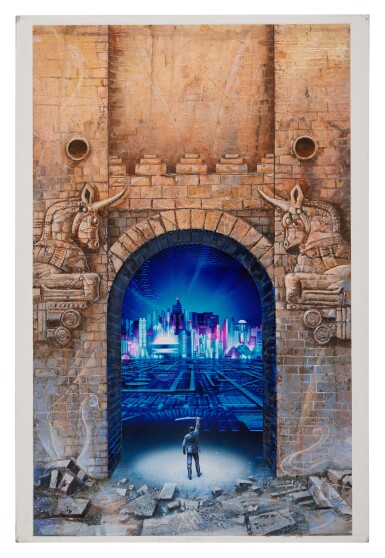Snow Crash
Snow Crash

Bruce Jensen
“Snow Crash · Neal Stephenson/Bantam”, 1992. The original painting used as the cover art for the 1993 mass-market paperback edition of "Snow Crash."
Lot Closed
March 6, 07:20 PM GMT
Estimate
30,000 - 50,000 USD
Lot Details
Description
Acrylic on paperboard and polymer clay, over digital chromogenic print (29 x 18 in., 30 x 20 in. with matting), signed “© JENSEN 92” to recto and “Snow Crash · Neal Stephenson/Bantam / Bruce Jensen / 41-61 53rd St Woodside, NY 11377 / © 1992 / 9/27/92” to verso.
THE ORIGINAL PAINTING USED AS THE COVER ART FOR FIRST PAPERBACK EDITION OF SNOW CRASH, BY FAMED SCIENCE FICTION COVER ARTIST BRUCE JENSEN
Bruce Jensen is one of the most sought-after science fiction cover artists, having designed book covers for works by not only Neal Stephenson, but also Kim Stanley Robinson, Philip K. Dick, Robert Heinlein, A.E. van Vogt, Arthur C. Clarke, and many others. In addition, Jensen was the artist for the unfinished 1989 graphic novel adaptation of William Gibson’s Neuromancer (1984), the book widely considered to be the other pillar of the “cyberpunk genre” alongside Snow Crash.
This artwork depicts the main character Hiro Protagonist, katana held high above the head with his right hand, wearing a short, stylized men’s kimono top with pants and motorcycle boots. Hiro stands underneath a Sumerian gate spanning the entire length of the work on both sides, painted in relief with acrylic on a surface of variable height, with two bull’s heads to the sides of the gate, symbolizing power and authority in Sumerian mythology. Rubble lay behind Hiro and the gate, while in front lies “the Street,” the visual representation of the Metaverse that stretches 65,536 kilometers around the black sphere that makes up the virtual world.
As Stephenson writes:
“[The Street] is the brilliantly lit boulevard that can be seen, miniaturized and backward, reflected in the lenses of [Hiro’s] goggles. It does not really exist. But right now, millions of people are walking up and down it…Like any place in Reality, the Street is subject to development. Developers can build their own small streets feeding off of the main one. They can build buildings, parks, signs, as well as things that do not exist in Reality, such as vast hovering overhead light shows, special neighborhoods where the rules of three-dimensional spacetime are ignored, and free-combat zones where people can go to hunt and kill each other. The only difference is that since the Street does not really exist—it’s just a computer-graphics protocol written down on a piece of paper somewhere—none of these things is being physically built. They are, rather, pieces of software, made available to the public over the worldwide fiber-optics network. When Hiro goes into the Metaverse and looks down the Street and sees buildings and electric signs stretching off into the darkness, disappearing over the curve of the globe, he is actually staring at the graphic representations – the user interfaces – of a myriad different pieces of software that have been engineered by major corporations.”
Vividly depicted here by Bruce Jensen, Neal Stephenson’s Metaverse concept from Snow Crash has had an outsized influence on the technology industry that is so integral to our modern world: Snow Crash is rumoured to have been required reading for Facebook employees even before the company became known as Meta, and the panoptic 3-D “Earth” application found in Snow Crash was the inspiration for Google Earth. In addition, the ways in which virtual reality, digital currencies, mobile computing, and more have all developed over the past thirty years owes much to Neal Stephenson’s arresting vision of the world as depicted in Snow Crash.
